Welcome to our comprehensive guide featuring the top catering company websites, expertly curated by our talented team of web designers and developers. After diligently evaluating hundreds of catering company websites, we’ve ranked them based on crucial factors such as design, functionality, uniqueness, user experience, and other important grading criteria.
Our goal is to provide catering companies with an abundance of inspiration and ideas for their next website, ensuring an online presence that effectively showcases their culinary creations and entices potential clients.
In this article, we’ll explore the key components of a successful catering company website, including user-friendly navigation, appetizing visuals, engaging content, detailed service offerings, and a streamlined inquiry process that caters to various event types and sizes. This isn’t our first similar article – if you browse our best websites article you’ll find a collection of thousands of awe-inspiring websites organized into dozens of different business industries.
Join us as we delve into the world of exceptional catering company web design, and learn how to craft an online experience that sets your business apart in the competitive catering landscape.
Top Catering Company Website Designs
1. Chic Chef Catering
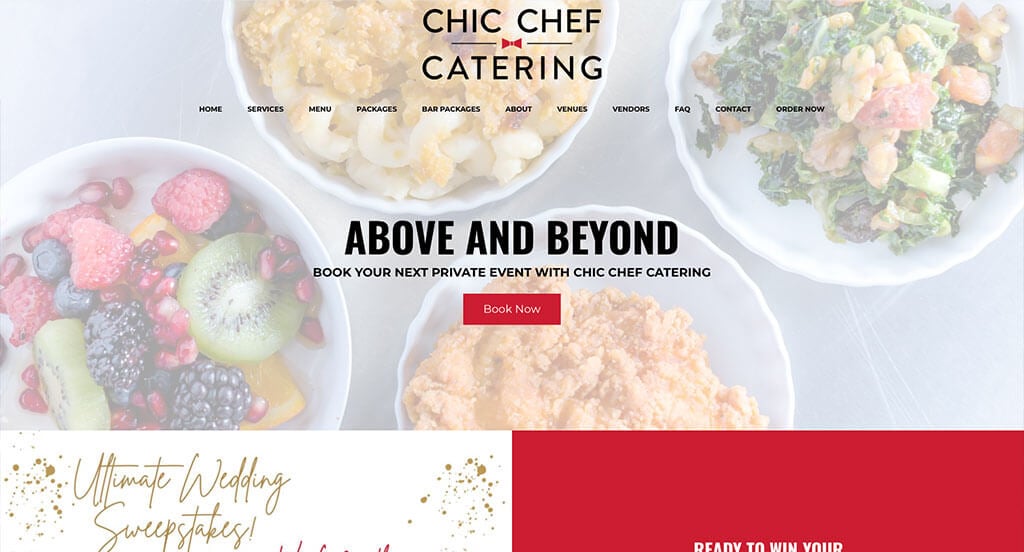
This is a great website example for caterers looking for a custom web design. The layout of this catering website was thoughtful because of their stunning imagery. The section for all their awards was absolutely a consideration when ranking Chic Chef Catering in this list of the most professional catering websites. The simplistic template was a marketing feature we noticed right away. If you are looking for template ideas for your next catering site, give some thought to this one.
2. Catering by Micheals
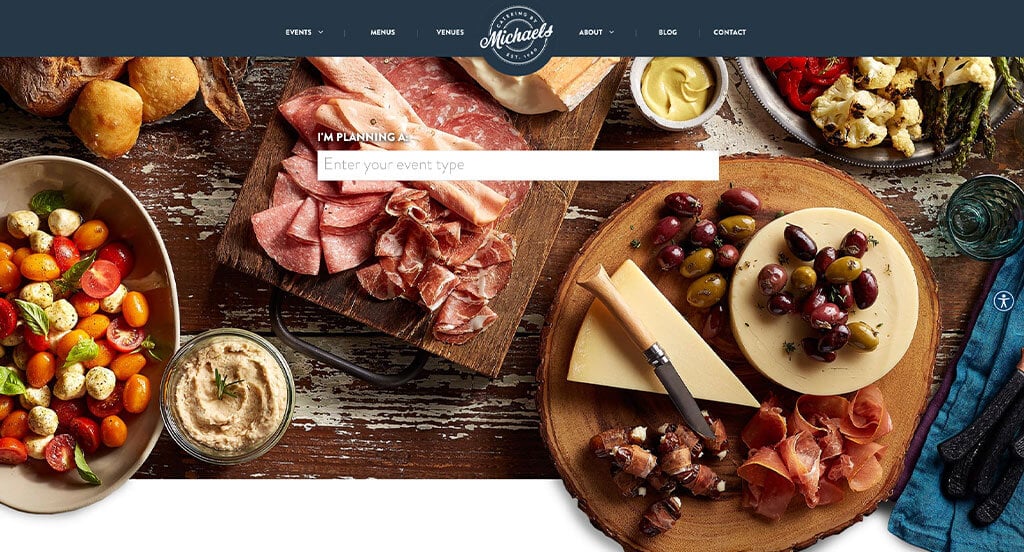
This is a good example of a website design for caterers who are looking for a professional website layout. The version of search bar was definitely the most impactful quality in the homepage of Catering by Micheals. Another feature in this professional catering website was the addition of a blog. They had internet marketing in mind when building the different foods for different types of events. Give some thought to the creative design of this catering website when developing your next custom website.
3. Tasty Catering
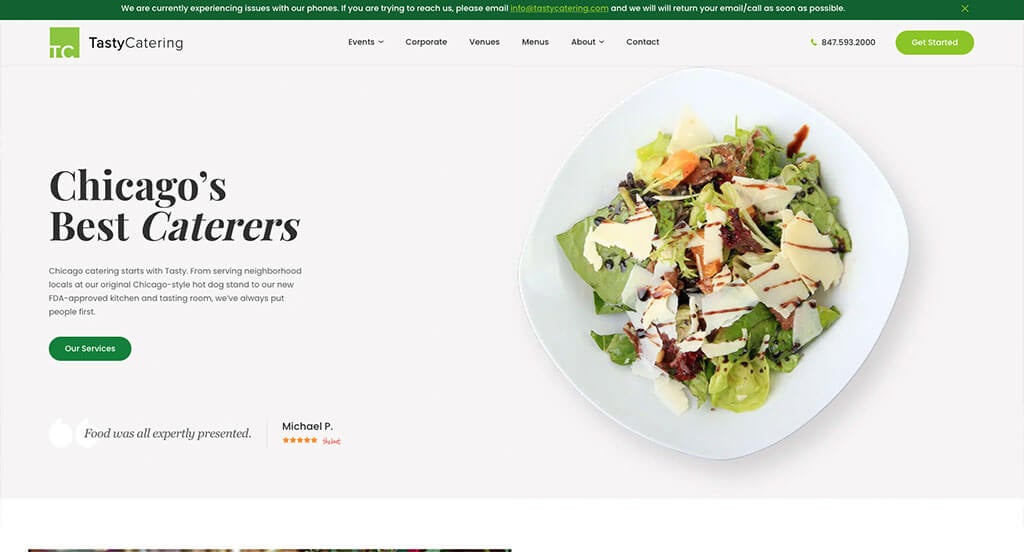
This is a great website design idea for a catering company looking for inspiration for a custom websites. After scrolling past the navigation of this catering site, you’ll notice the green and blue accents. The alternating imagery was another reason why we included this website in our list of the best website layouts for caterers. Tasty Catering clearly had a focus on website marketing when creating the professional text for their website. What a great website to review when building out your next catering website!
4. Blue Plate
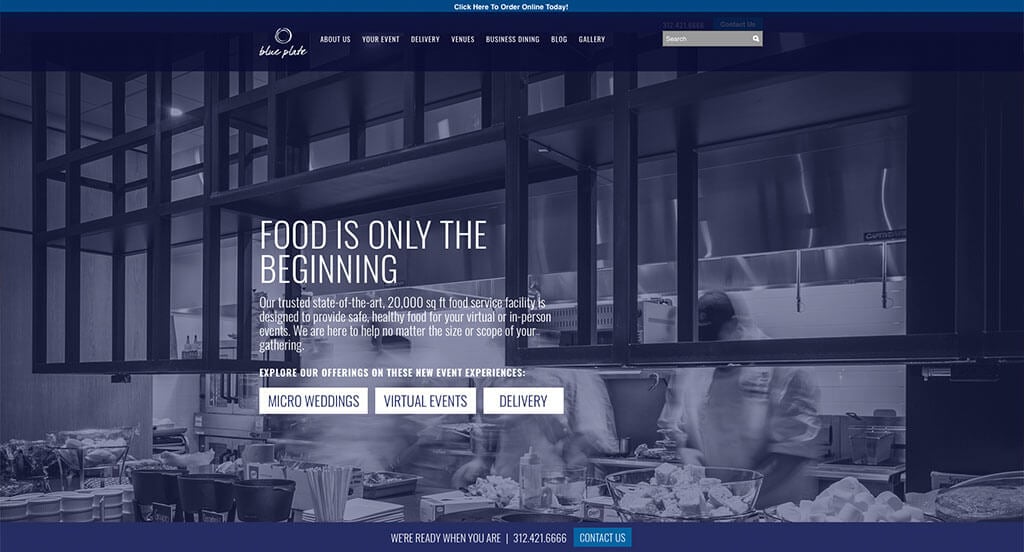
This is a good example of a catering company website design for someone looking for a professional layout. The most attention grabbing aspect of this catering website was definitely the interesting logo design used effortlessly throughout the page. The layout with no distractions was absolutely a consideration when ranking Blue Plate in this list of the most professional catering websites. Blue Plate clearly had website marketing in mind when building the simple navigation for their website. If you are looking for template options for your next catering site, give some thought to this one.
5. Tall Guy and a Grill Catering
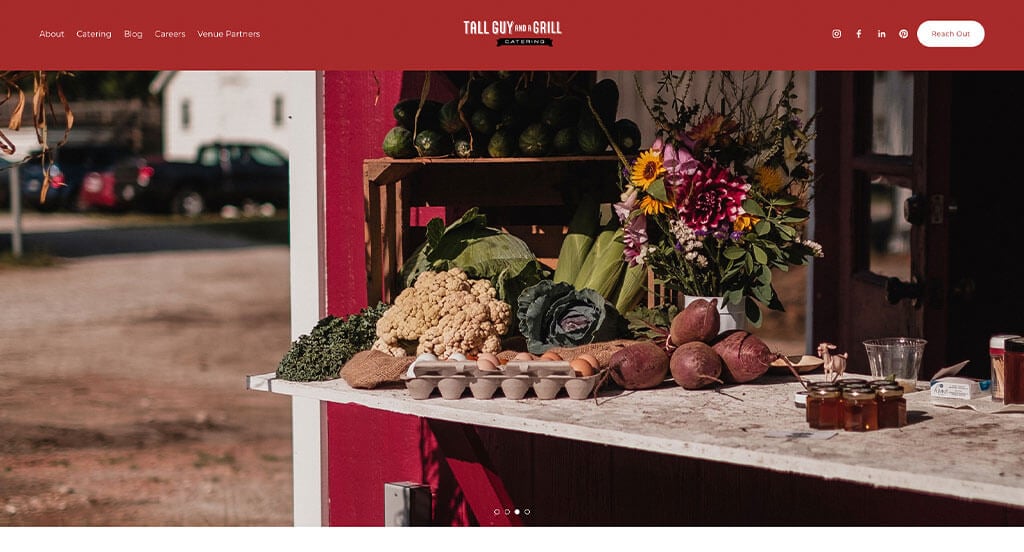
Tall Guy and a Grill Catering has a great looking website that uses white, red, orange and a bit of black for their color scheme. Of all the professional caterer websites we reviewed, one of the features in this custom website we liked was their high quality visuals. The unique and professional text choice was a nice touch for a custom site. Tall Guy and a Grill Catering clearly had a focus on website accessibility when creating the domain for their website that matches their company name. For caterers looking for examples for their next website layout, this will for sure be one to consider.
6. Anmol South Asian Kitchen
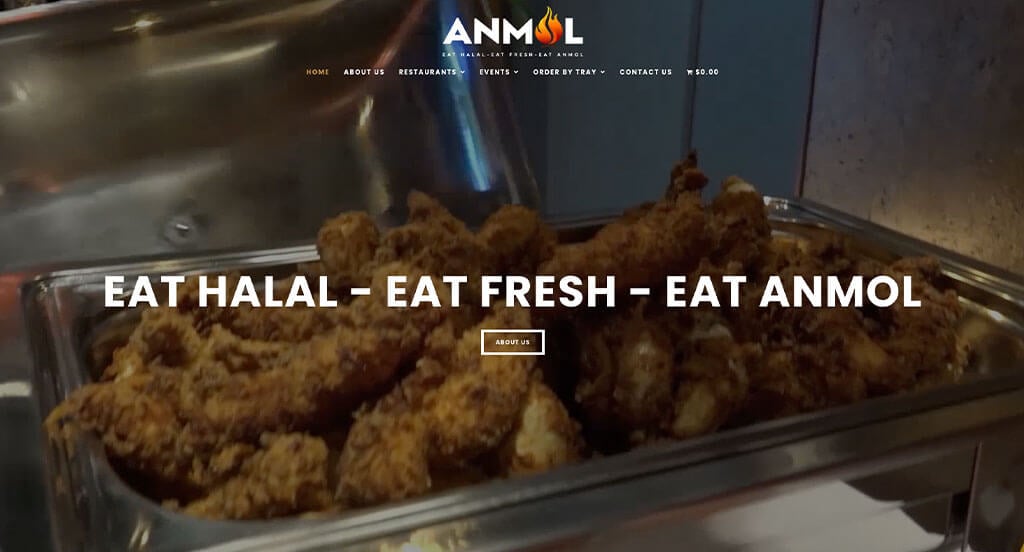
This is a great template example for a catering company looking to pull inspiration for their custom website. As you scroll through the homepage of the website, one of the design qualities we liked was the use of an automatically playing video. The stunning logo design was another design quality in this custom food site we enjoyed. From a marketing viewpoint, we liked the way this site utilized an area for client testimonials. Be sure to consider the great design of this catering website when developing your next custom website.
7. Chowgirls Catering
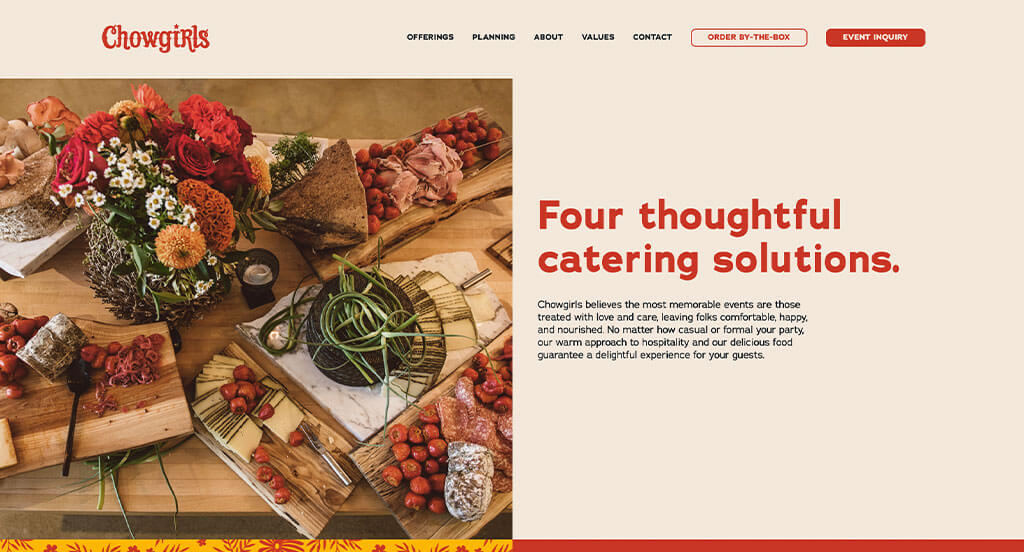
We quickly noticed the cream color mixed with a variety of bright colors used in the Chowgirls website, which we liked because it created a homey but energetic feel. After scrolling past the navigation of this food website, you’ll immediately notice their fonts that automatically convey an emotion. Another design quality in this creative catering website was the use of patterns for borders on their images. Chowgirls clearly had a focus on ease of use when building the well-labeled navigation bar for their website. Don’t scroll past this website when hunting for design ideas for your next catering website!
8. Sopranos Catering
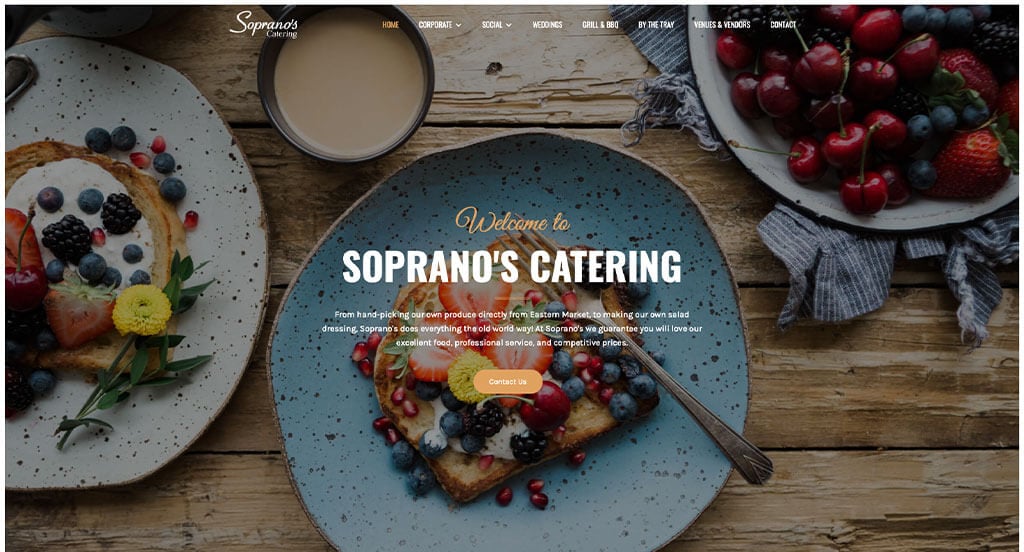
The website of Sopranos Catering ranked because it’s one of the nicer catering websites we reviewed. The layout of this food website was thoughtful because of their contrast in font using thick, thin, caps, lowercase, fancy and basic lettering. The use of small graphics throughout the site was also something about their site that didn’t go unnoticed. They clearly had website marketing in mind when designing the basic but captivating texture for their background of their website. There was no shortage of reasons to include this website in our list of websites for caterers to consider when building out their next website.
9. 3 Dudes & Dinner
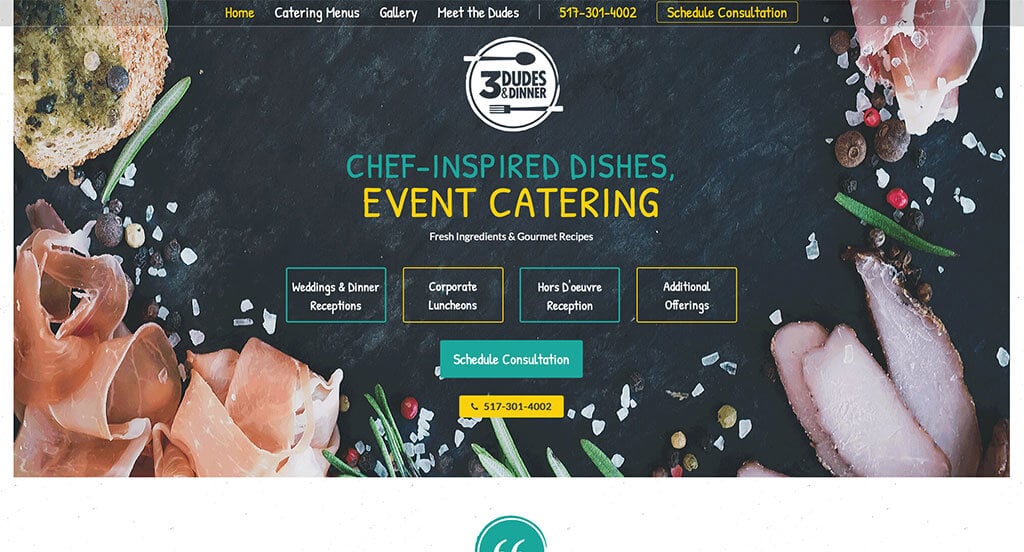
This is a great catering company web design example for anyone who is looking for a professional look and feel for their next site. We thought this was a good example of a homepage layout for caterers because of their blue and yellow accent colors. This custom catering website also does a good job with large buttons for simple contact and simple navigation. 3 Dudes & Dinner clearly had a focus on digital marketing when designing the page for customers to learn a bit more about the company’s team. Any website designer making websites for caterers will want to consider checking this website out.
10. Sterling Catering
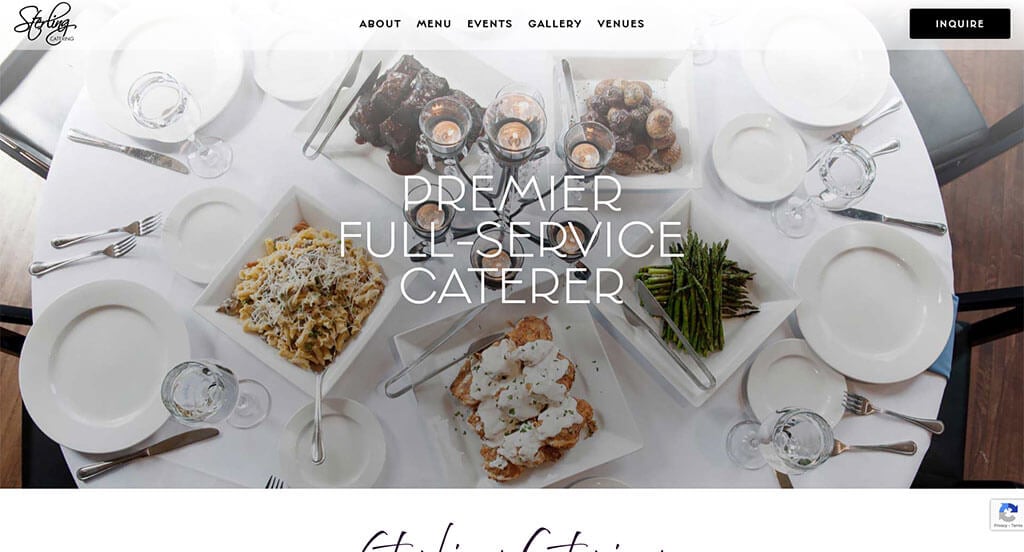
This is a good example of a catering website design for someone searching for a professional website design idea. Our web designers thought this was a good homepage design example for caterers because of their imagery and font to convey a luxurious feel. Another aspect of this clean catering site we liked was the page dedicated to their photo gallery. Sterling Catering clearly had ease of use in mind when building the menu for their site that was readable. If you are looking for template options for your next catering website, be sure to check this one out.
11. Deborah Miller
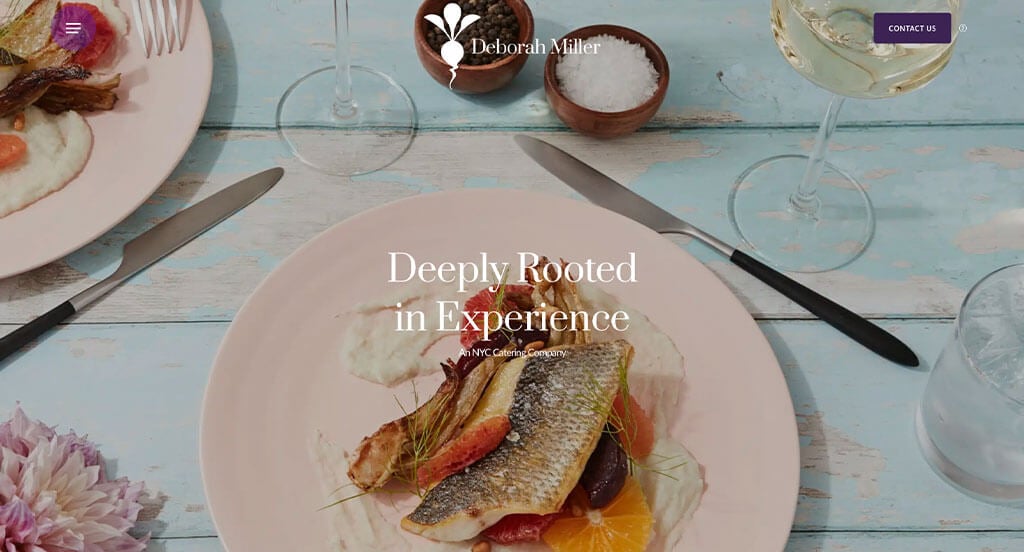
Sporting a clean and intuitive layout, this website keeps things simple for a catering site. Our web designers thought this was a good homepage design example for caterers because of their video that plays automatically. This professional catering website also does a good job with their mix of serif and sans serif fonts. Deborah Miller clearly had website accessibility in mind when creating the clearly labeled menu for their website. Give some thought to the great design of this catering website when developing your next website.
12. New York Catering Service
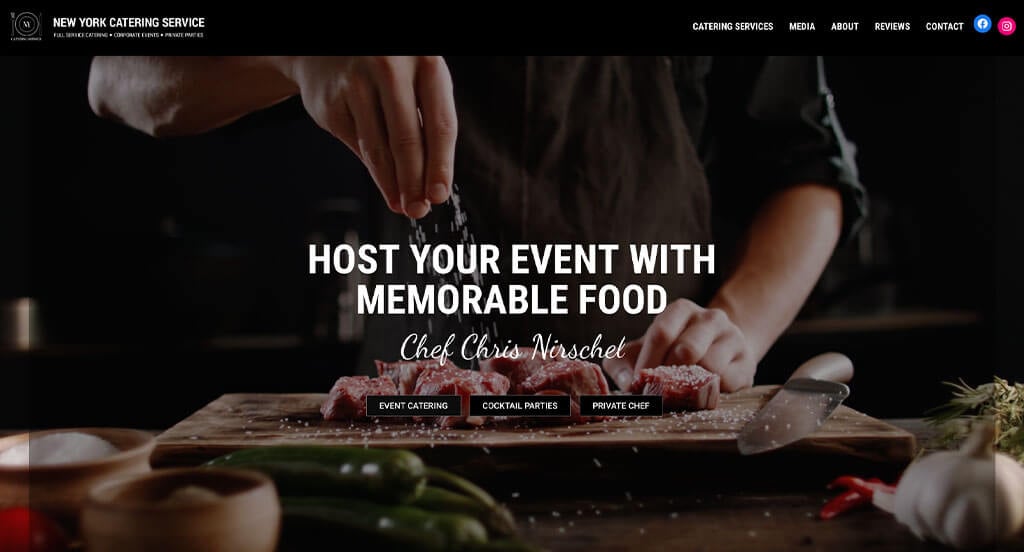
This is a great web design example for caterers that are looking for a professional look and feel. As you scroll through the homepage, one of the design qualities you’ll notice is their layout that balances and breaks up their content. Another thoughtful feature in this clean catering site we liked was the addition of a blog. New York Catering Service clearly had a focus on digital marketing when creating the short and to the point paragraphs. What a great website to review when building out your next catering website!
13. Relish
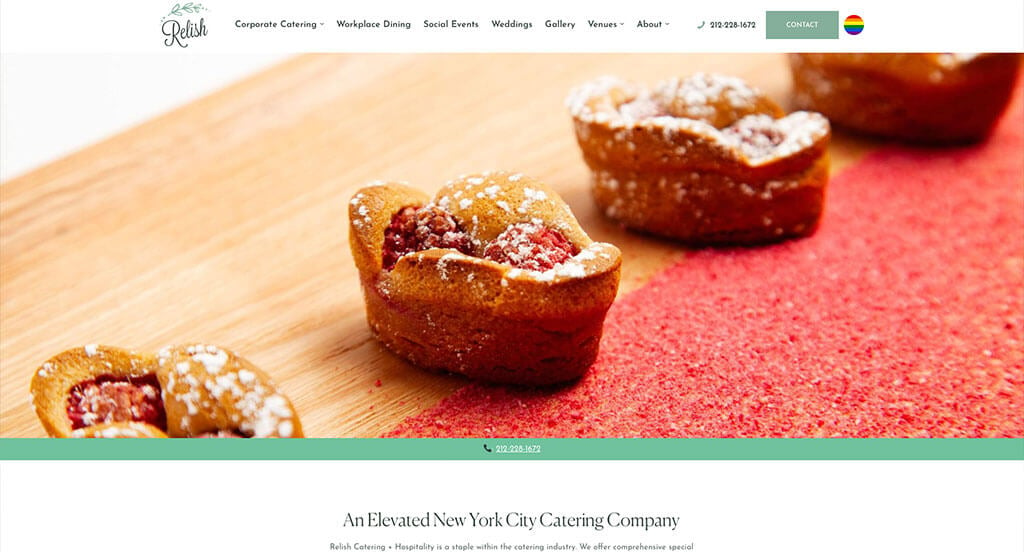
The white, seafoam green and dark grayish-green color scheme of this catering site stood out to us because of it’s simplistic feel. After scrolling past the navigation of this catering website, you’ll notice their sophisticated logo design. The brightly lit imagery was refreshing for a unique site. Relish had conversions in mind when designing the page related to the press. For caterers who are looking for ideas for their next website, this example will definitely be one to keep in your back pocket.
14. DISH Food & Events
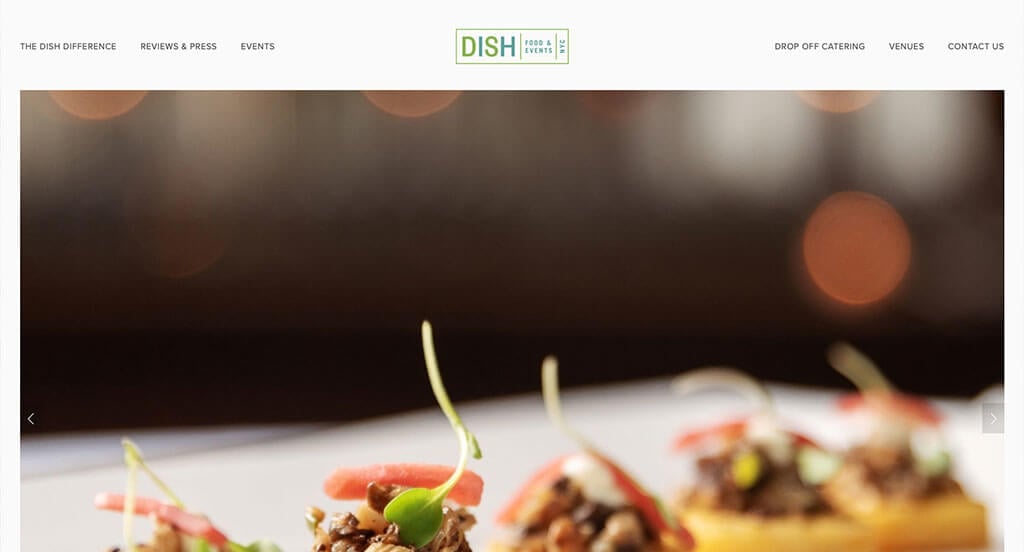
This is a good example of a catering website design that can give inspiration to other companies for a professional website. After scrolling past the header of this catering site, you’ll immediately notice their use of buttons to enhance usability. The slideshow for some of their imagery was another unique quality in this custom catering website we enjoyed. They clearly had a focus on conversions when including social media into their website. These were just a few of the numerous qualities in this website we had to consider when putting together this list of top websites for caterers.
15. Crave Catering
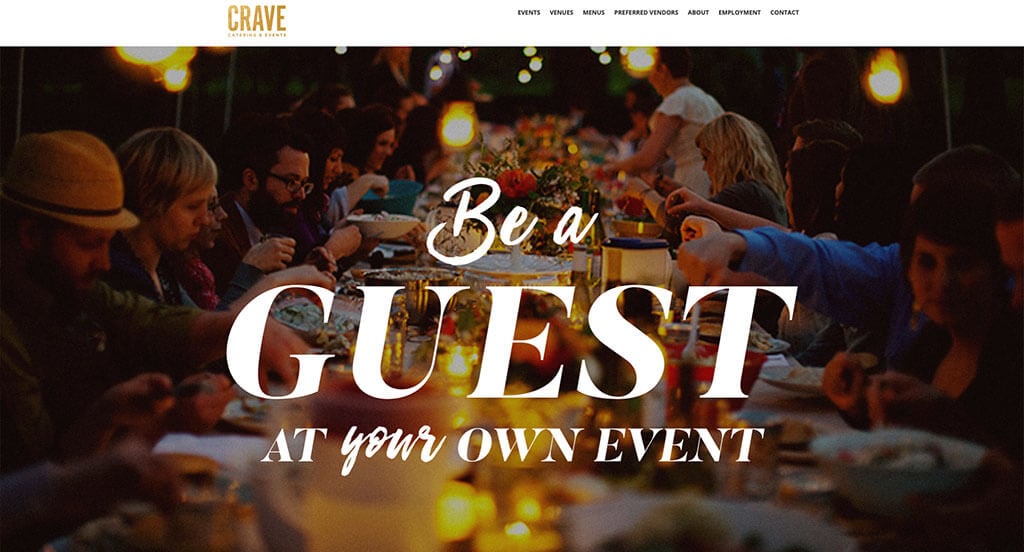
This is a good example of a website design for caterers looking for a professional layout for their next custom design. After scrolling past the header of this catering site, you’ll immediately notice their slight animations. Another design quality in this clean catering site was the inclusion of a map. Crave Catering had website marketing in mind when creating the simple navigation for their website. With so many great reasons to consider this catering website, it’s no wonder we included it in this list of the best websites!
16. From Scratch Catering
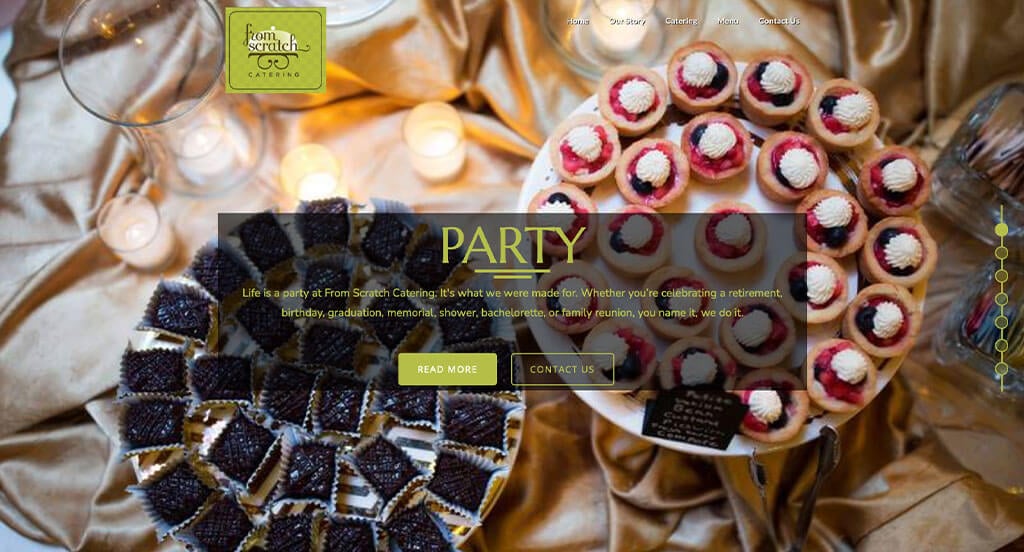
This is a great example for caterers who are looking for a professional website layout. The elegant logo design was definitely the most impactful quality in the homepage of this website. This custom catering site also does a good job with their addition of a lime green accent color. From Scratch Catering clearly had a focus on internet marketing when creating the videos displayed throughout their site. If you are looking for template examples for your next catering site, give some thought to this one.
17. Renard’s Catering
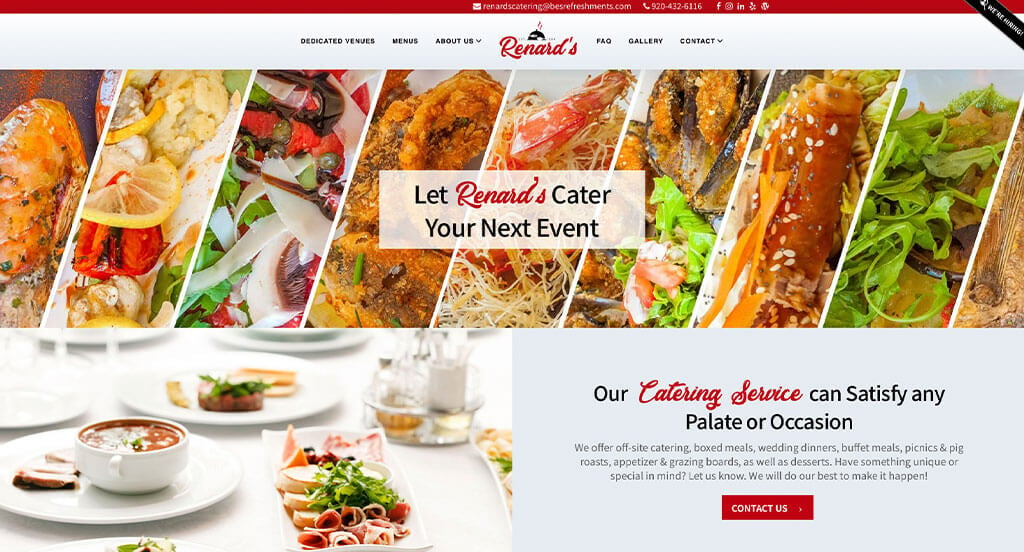
Renard’s Catering has a great food website that uses black, white and red for a color scheme. Our web designers thought this website was a good example for caterers because of their contrast in text. The interesting logo was another aspect of this custom catering website we enjoyed. They had website marketing in mind when building the imagery to help break up content throughout their website. You won’t be disappointed after reviewing this website for design ideas for your next website!
18. Three Guys and a Grill Catering
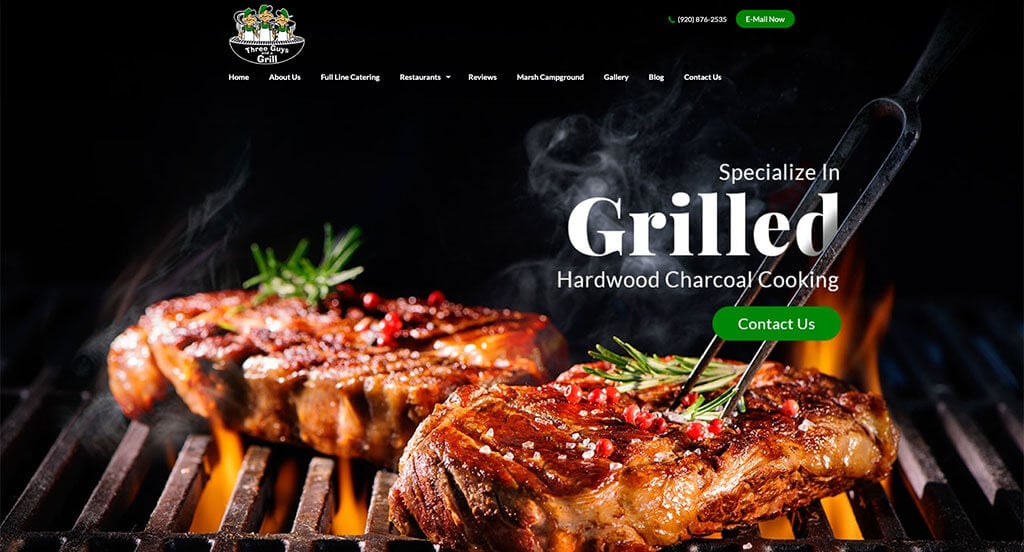
The black, green and white colors used in this custom catering website stood out to us because it creates a unique feel for their website. After scrolling past the navigation of this catering website, you’ll notice the section for their awards. Another feature in this creative catering website was their detailed map. They clearly had website accessibility in mind when designing the photo gallery. Be sure to consider the great design of this catering website when building your next website.
19. Saz’s Hospitality Group
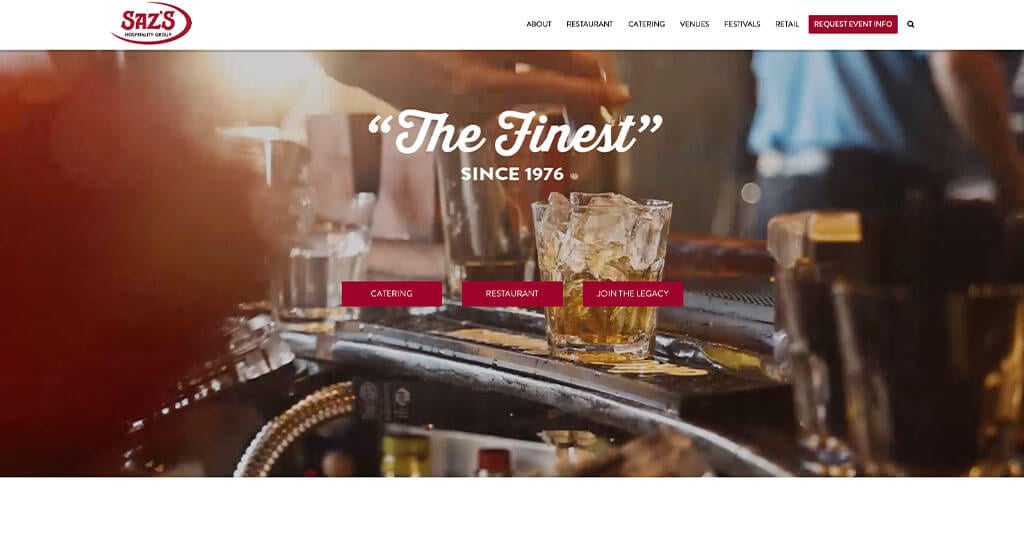
This is a great example for caterers who are looking for a professional website layout. Having a news section in their site was definitely the most impactful quality in the homepage of Saz’s Hospitality Group. Another design quality in this professional catering site we liked was their use of buttons. They had digital marketing in mind when creating the clearly labeled menu for their website. Don’t scroll past this website when considering design ideas for your next catering website!
20. Chef Jack’s
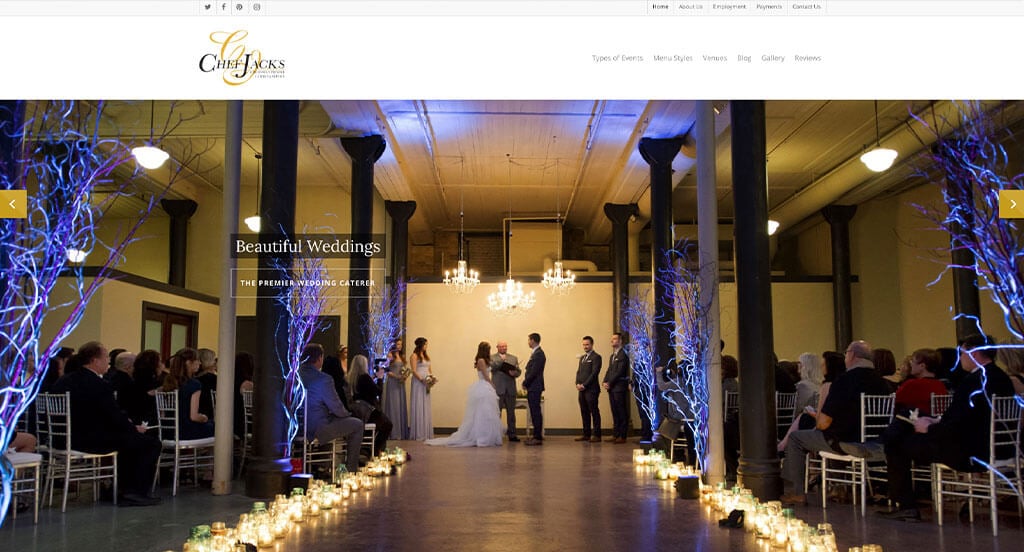
We appreciated how this catering website used the colors of white, black and gold into a custom web design. After scrolling past the navigation of this catering site, you’ll notice the use of images and color blocks to break up their content. Another feature in this creative catering site was the high quality visuals. They clearly had ease of use in mind when designing the larger font for their titles. Give some thought to the one-of-a-kind design in this catering website when developing your next custom website.
21. Chef By Request
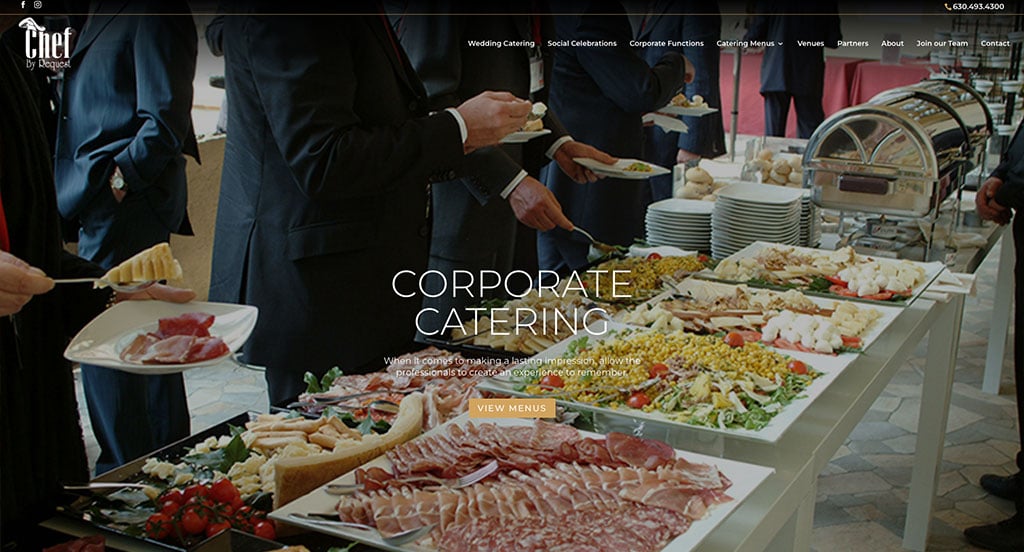
This is a great website design idea for a catering company that is looking for inspiration for their next custom site. As you scroll through the homepage, one of the qualities you’ll notice right away is the variety of awards displayed in their site. Their navigation bar with organized categories was absolutely a consideration when ranking Chef By Request. They had website marketing in mind when creating the domain for their website that matches their company’s name. With so many quality reasons to consider this catering website, its obvious why we included it in this list of the best sites!
22. Mintahoe Catering & Events
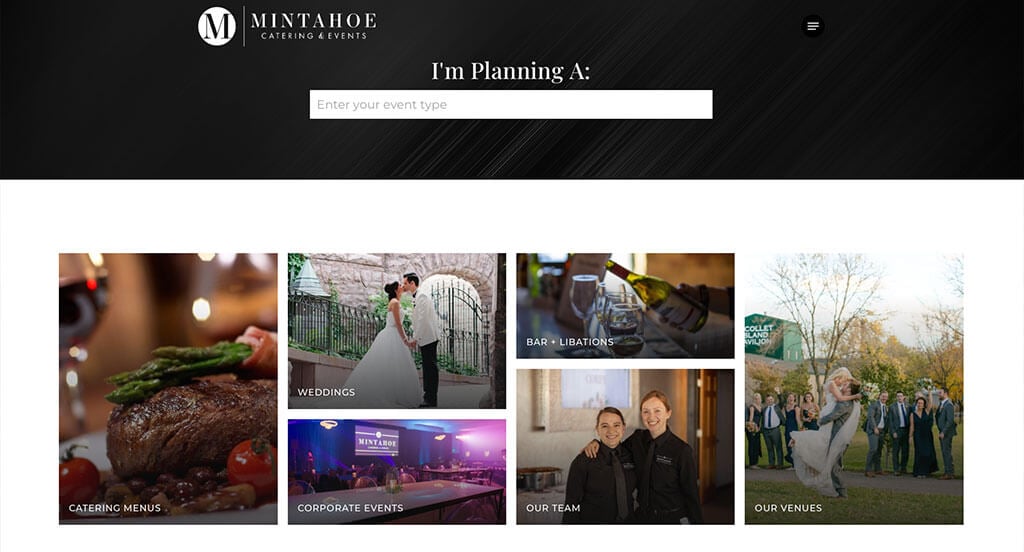
We immediately noticed the grayscale color scheme seen in the Mintahoe Catering & Events website, which we liked because it creates a sophisticated design. After scrolling past the header of this food site, you’ll notice the “I am planning a…” search bar. The page for their customer reviews was a unique choice for a professional website. Mintahoe Catering & Events had website accessibility in mind when building the contact information that was easy to find in their website. Any website designer making websites for caterers will want to consider checking this website out.
23. K.J. Catering
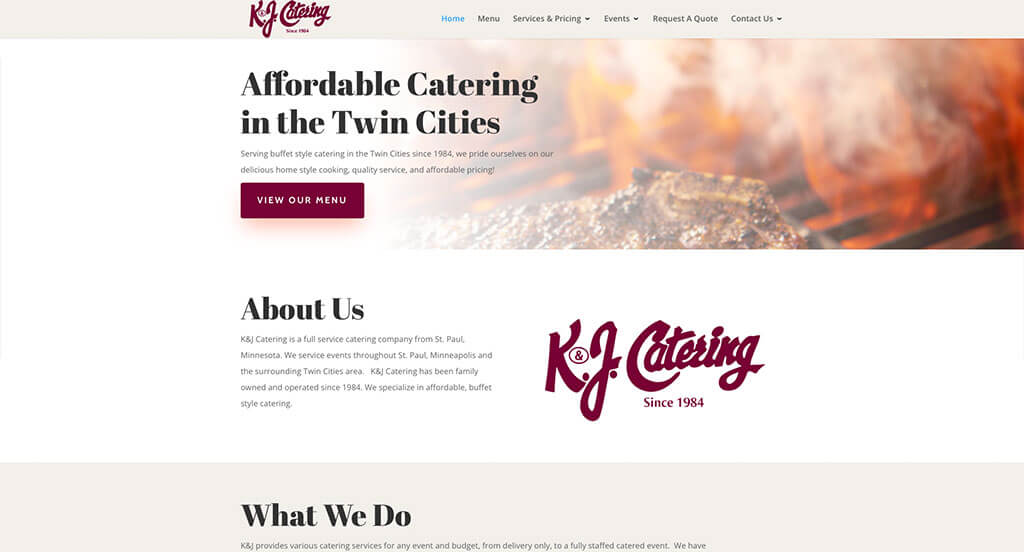
The tan, white, maroon and black color palette used in this custom catering site stood out to us because it creates a stunning feel. As you scroll through the homepage, one of the design qualities we liked was the use of drop downs in their navigation bar. The content that was well balanced was definitely refreshing for a unique website. They had digital marketing in mind when designing the customer review area for their website. For caterers looking for ideas on their next website, this example will definitely be one to take a look at.
24. Vittles Catering & Deli
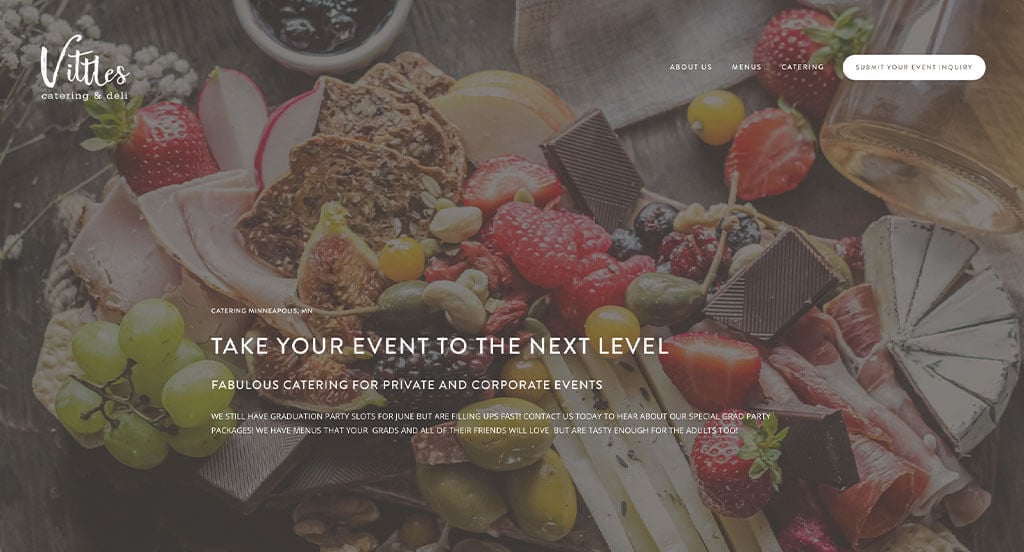
The Vittles Catering & Deli website has a very classy feel to it, thanks to its blended use of gray, white and orange. As you scroll through the homepage of this website, one of the design qualities we liked was their font choices. This professional catering website also does a good job with their high-quality imagery. Vittles Catering & Deli clearly had internet marketing in mind when creating the white space seen throughout their pages. So many attractive qualities to consider when ranking this website.
25. Steven’s Catering
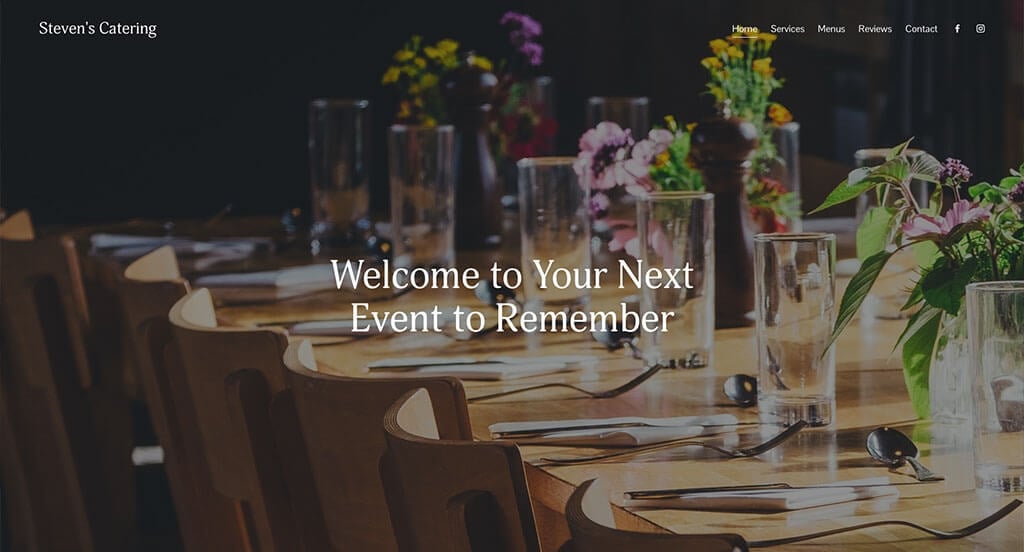
We immediately noticed the black and white color scheme utilized in the Steven’s Catering website, which we liked because it allows the images to be the main focus of the site. One of the design features we liked most in the homepage of Steven’s Catering was having buttons that are easy to access to help enhance usability. Another thoughtful feature in this creative catering website was their large imagery to break up the content. Steven’s Catering clearly had a focus on ease of use when building the domain for their website that matches their company’s name. Another amazing website to add to this list!
26. Rustic Taps & Catering
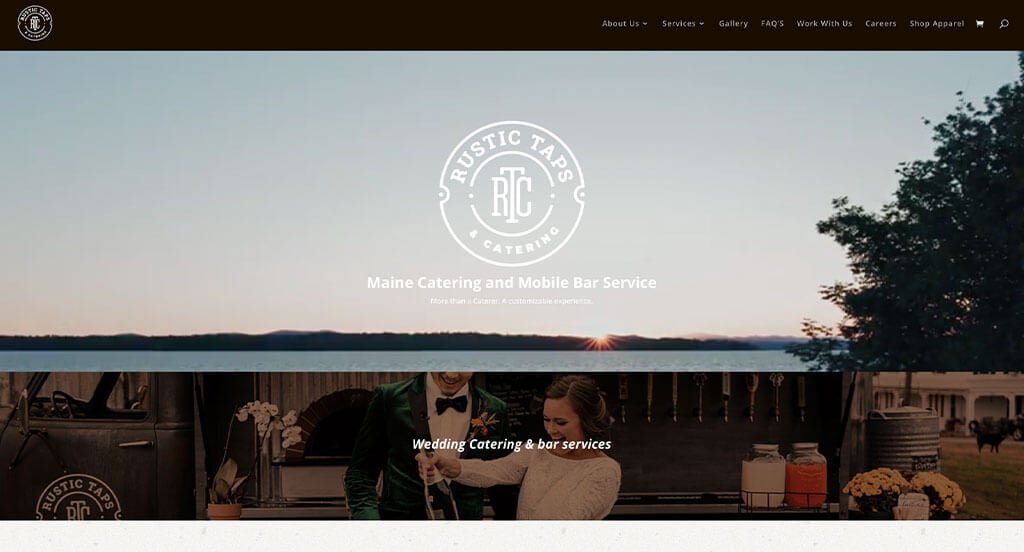
Sporting a clean and intuitive layout, this site keeps things simple for a catering company. After scrolling past the header of this catering website, you’ll notice their textured backgrounds. Another thoughtful quality in this custom catering site we noticed was their logo seen in a variety of pages. Rustic Taps & Catering clearly had digital marketing in mind when adding the automatically playing video onto their homepage. Don’t forget to check this website out while looking through our list of the best catering sites!
27. Bar Harbor Catering Company
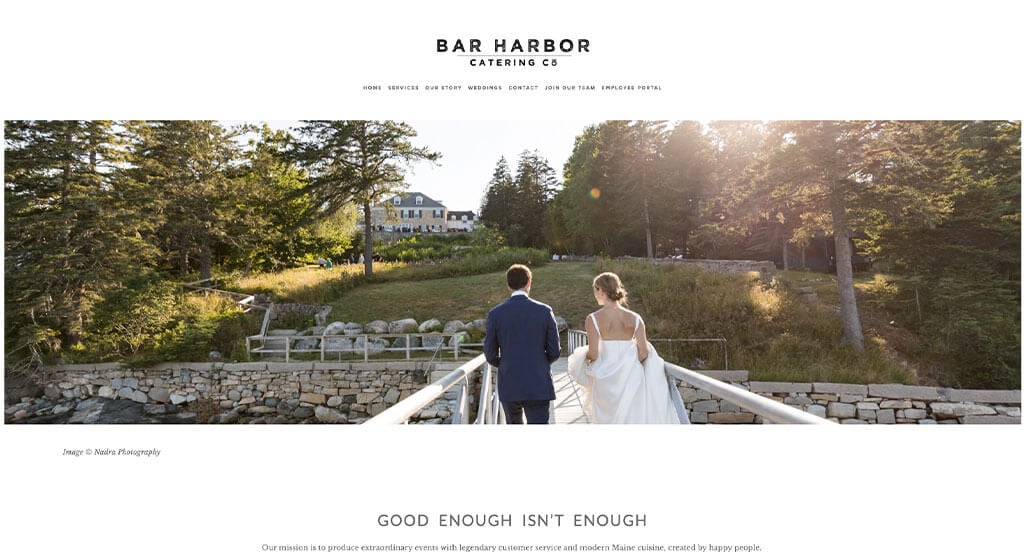
The Bar Harbor Catering Company website has a very professional feel to it, thanks to its unique use of black and white. After scrolling past the navigation of this catering website, you’ll immediately notice their display of awards. This clean catering website also does a good job with their captivating visuals. Bar Harbor Catering Company clearly had a focus on ease of use when building the interlinking text for their website. With so many great reasons to consider this catering website, it’s no wonder we included it in this list of the best websites!
28. Blue Elephant Catering
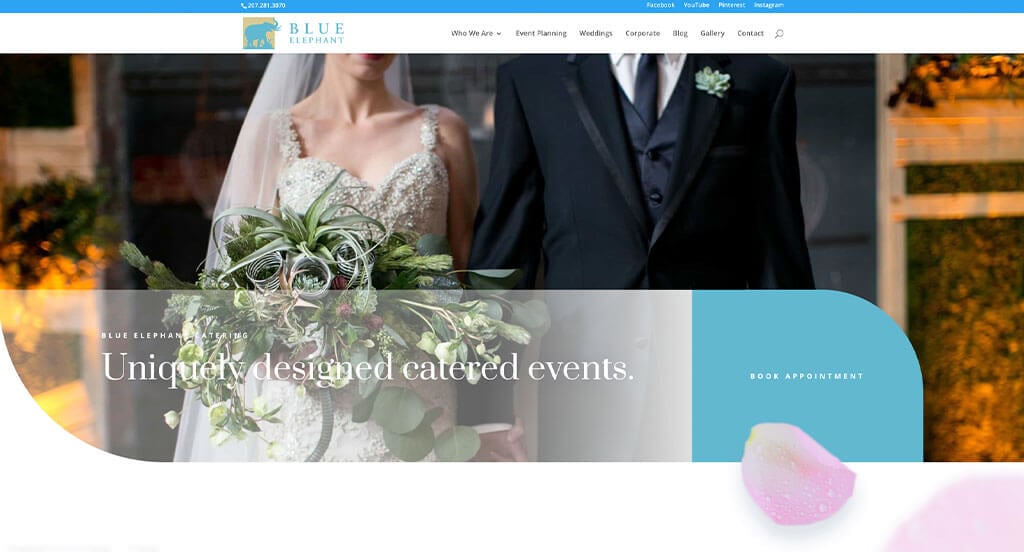
This is a great catering web design example for anyone looking for a professional look and feel. Of all the custom caterer websites we reviewed, one of the features in this custom website that stood out was their contrast in fonts. This custom catering site also does a good job with their page filled with “props”. The addition of a blog helped make this one of the best catering websites we considered. If you are looking for template options for your next catering website, be sure to check this one out.
29. Sugarsnap Catering
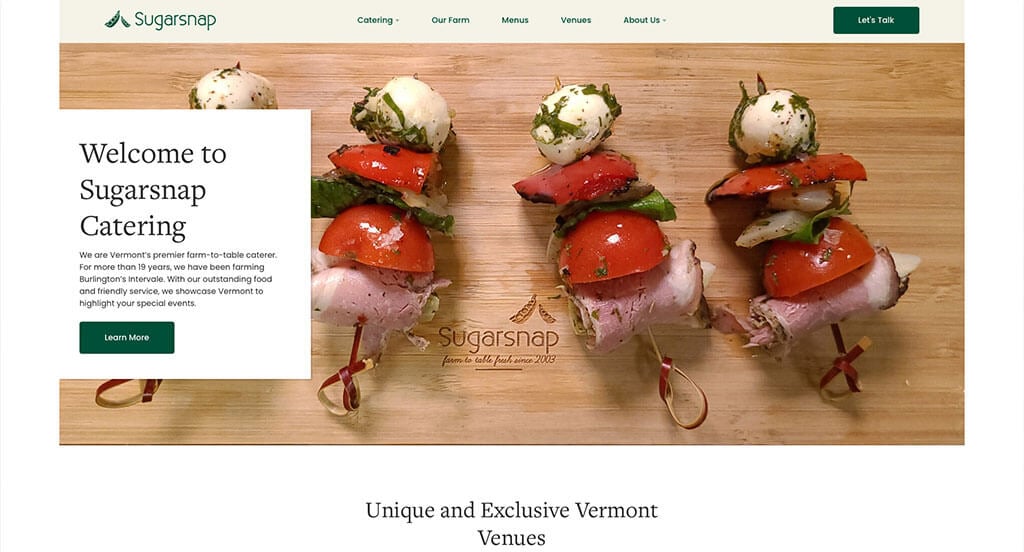
The cream, green and white color scheme seen in this custom catering website stood out to us because it creates a more homey feel. Our web designers thought this was a good example of a homepage layout for caterers because of their simplistic logo design. The layout that was aesthetically pleasing was a nice touch for a unique site. From a marketing viewpoint, we really liked the way they utilized a page for sample menus. Give some thought to the one-of-a-kind design of this catering website when developing your next custom website.
30. The Hind Quarter
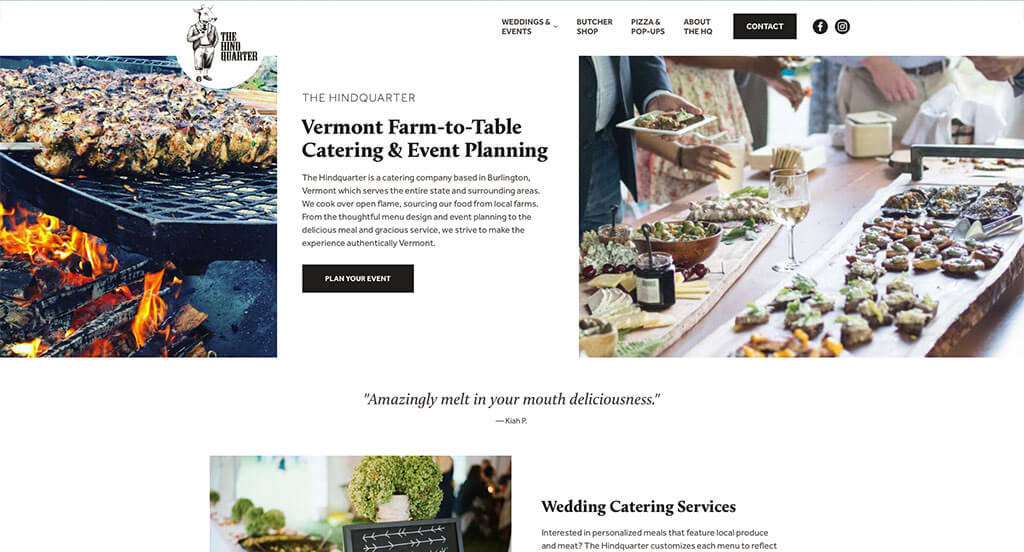
This is a good example of a website layout for a catering company looking for inspiration for their next custom web design. Our web designers thought this website was a good design idea for caterers because of their organization for their images. Another feature in this creative catering site was their photos that were labeled so customers can see what some of their options are. The clearly labeled menu helped make this one of the top catering websites we considered. Be sure to consider the one-of-a-kind design of this catering website when developing your next website.
31. RSVP Catering
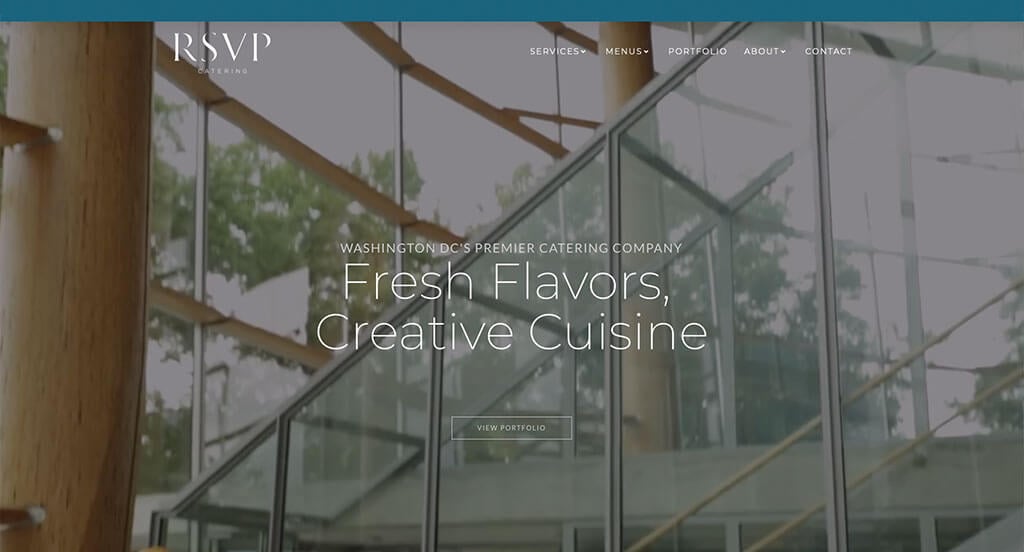
This is a great website design example for caterers who are looking for a custom look and feel for their next site. Our web designers thought this website was a good example for caterers because of their stunning template. Their thoughtful imagery was refreshing for a professional site. They had digital marketing in mind when creating the portfolio labeling what type of event the food was presented at. What a great website to review when designing your next website!
32. Mobile Pig-Nic Catering
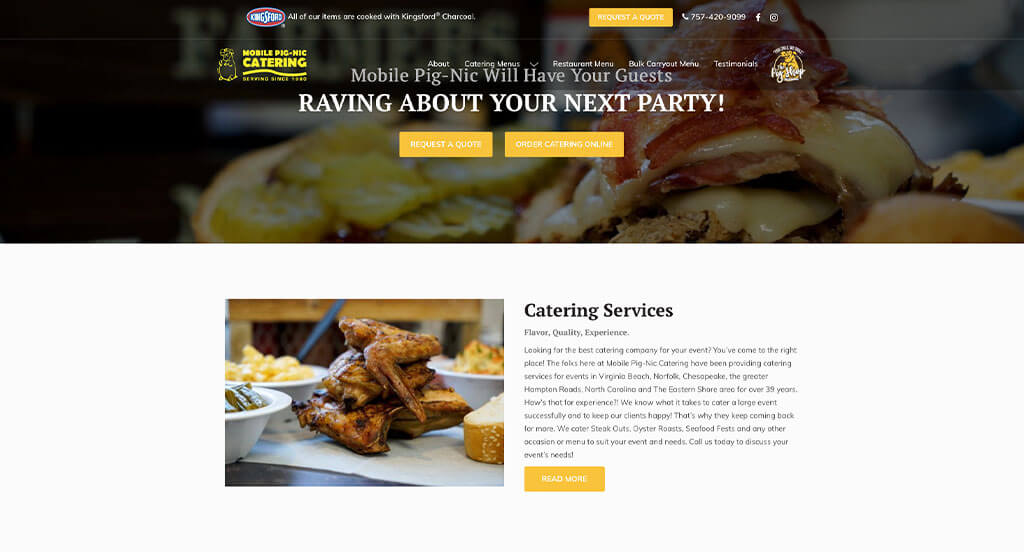
This is a good example of a catering design to check out when looking for inspiration for a professional looking website. While most catering websites share this quality, we thought Mobile Pig-Nic Catering did a nice job sharing a menu with clearly labeled pricing. Their mascot that was both creative and adorable was a marketing choice we won’t forget. Mobile Pig-Nic Catering clearly had conversions in mind when creating the simple contact information for their website. For caterers looking for ideas on their next website, this example will definitely be one to keep in your back pocket.
33. Kathy’s Custom Catering
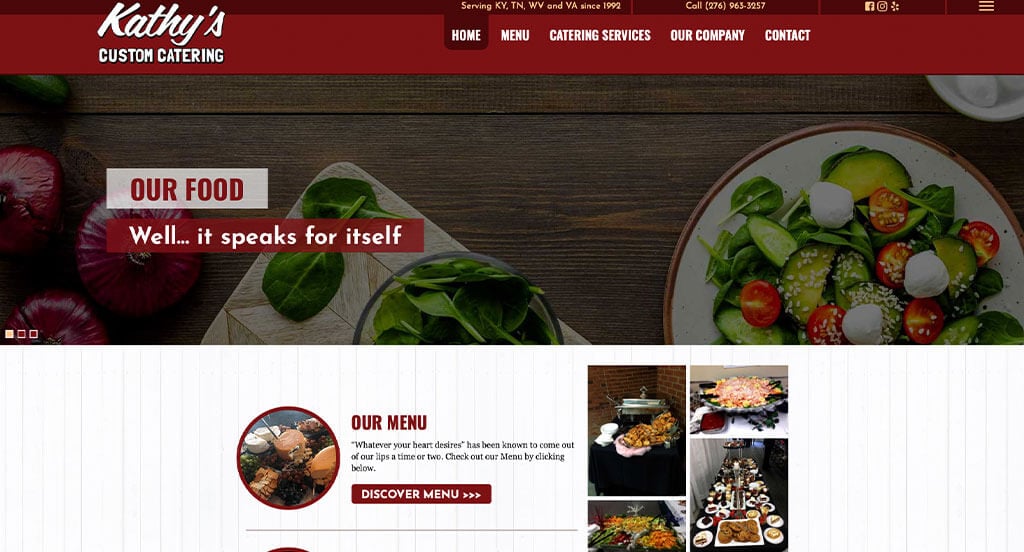
This is a great example for caterers who are looking for a custom look and feel for their next custom web design. After scrolling past the navigation of this catering website, you’ll notice their well chosen color scheme. The interesting background in this website helped it make it into our list of the best template ideas for caterers. They had website marketing in mind when creating the photo gallery that incorporates a variety of colors and foods into their website. These were just a few of the numerous aspects of this website we had to consider when putting together the list of top websites for caterers.
34. Kimberly Ashlee Catering
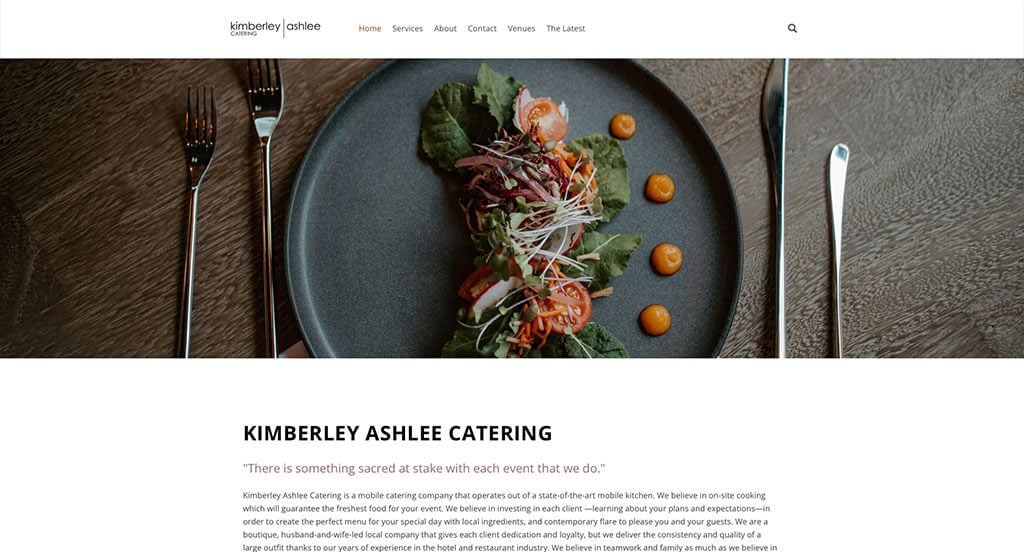
Our web designers noticed the black, white and brown color scheme in the Kimberly Ashlee Catering website, which we liked because it creates a sleek and professional design. We thought this website was a good design idea for caterers because of their use of bullet points to organize their information. The template that was free of distractions was a nice touch for a unique site. Kimberly Ashlee Catering clearly had a focus on website usability when designing the use of small icons in their website. Don’t scroll past this website when considering design ideas for your next catering website!
35. Catering By Design
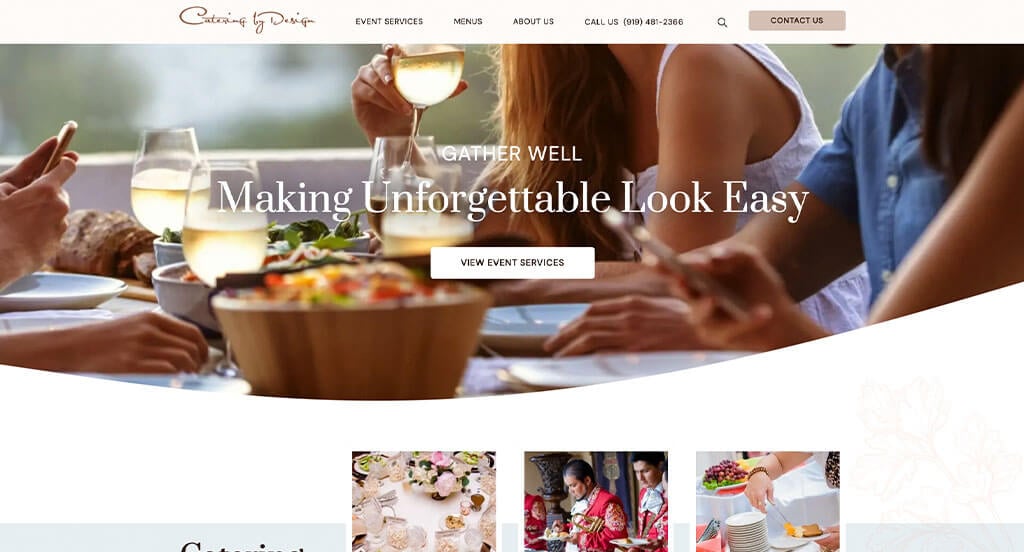
This is a good example of a website design for caterers who are looking for a professional layout. Our web designers thought this website was a good design idea for caterers because of their inclusion of graphics. Another feature in this custom catering website is was the amazing banners to break up content. They clearly had internet marketing in mind when creating the professional font for their website. If you are looking for template options for your next catering website, be sure to check this one out.
36. Salthouse Catering
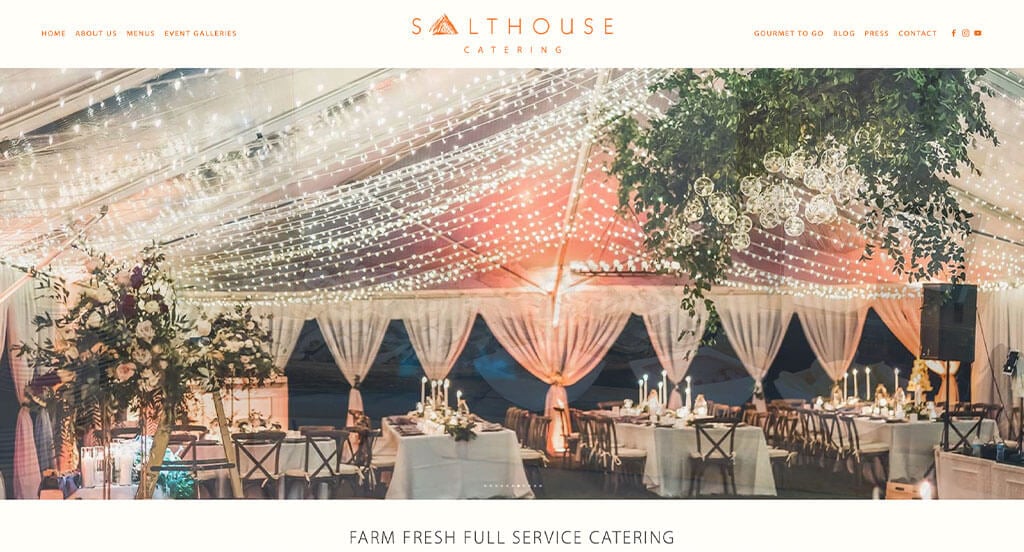
This is a good example of a website design for caterers looking for a professional layout. The slider for images was definitely the most impactful quality in the homepage of this website. The “sketches” placed throughout the site was a unique choice for a custom site. They clearly had conversions in mind when selecting the bright orange accent for their website. Be sure to consider the one-of-a-kind design of this catering website when developing your next custom website.
37. Hamby Catering & Events
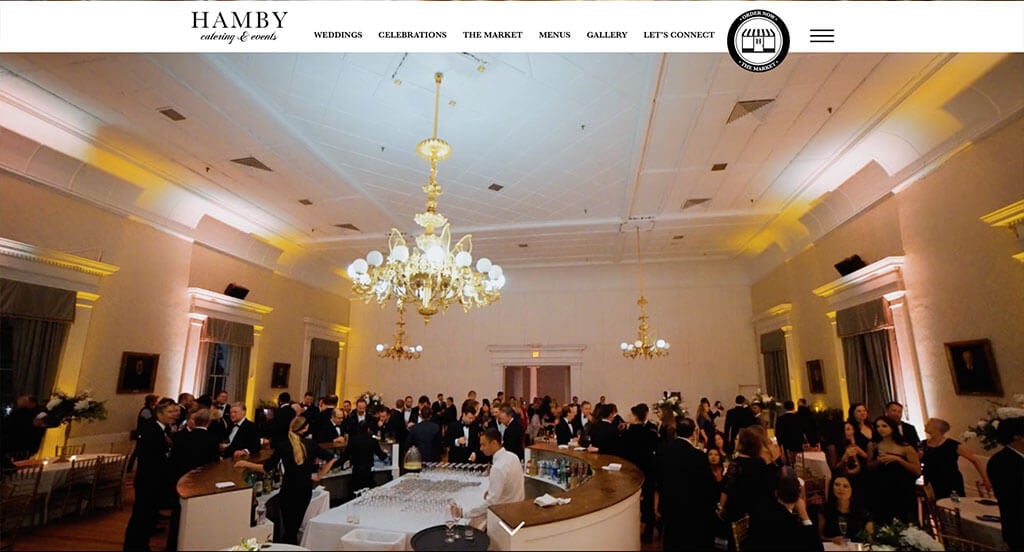
This is a great website design example for caterers looking for a custom layout. After scrolling past the navigation of this catering site, you’ll immediately notice their informational paragraphs. Their inclusion of social media was definitely refreshing for a custom website. They clearly had internet marketing in mind when building the videos showcasing their products. Give some thought to the great design of this catering website when developing your next website.
38. Carlyle’s Catering
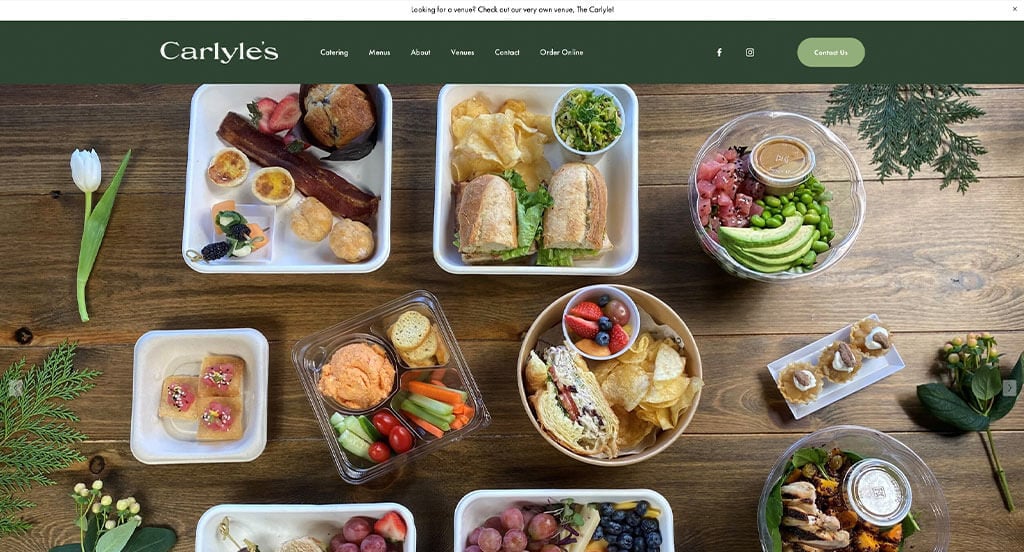
Carlyle’s Catering has a great catering website that uses white, dark green and light green for their color scheme. After scrolling past the header of this catering website, you’ll notice their well labeled navigation bar. The large and high-quality imagery was a nice touch for a professional website. Their colorful buttons used throughout the site helped make this one of the best catering websites we considered. For caterers looking for examples for their next website layout, this example will for sure be one to consider.
39. Talk of the Town Catering & Special Events
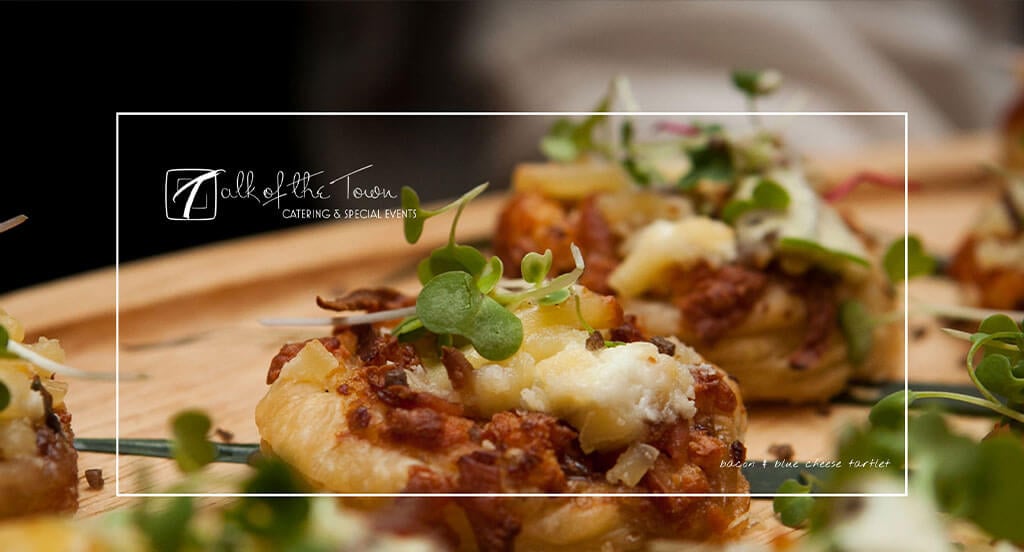
Talk of the Town Catering & Special Events has a well-designed catering website that uses a black, white and cream color palette, which we like because of its luxurious tone. After scrolling past the header of this catering site, you’ll immediately notice their delicate imagery. This clean catering website also does a good job with their creative fonts. Talk of the Town Catering & Special Events clearly had a focus on internet marketing when creating the reoccuring logo design for their website. What a great website to review when building out your next catering website!
40. Sweet Magnolia Catering
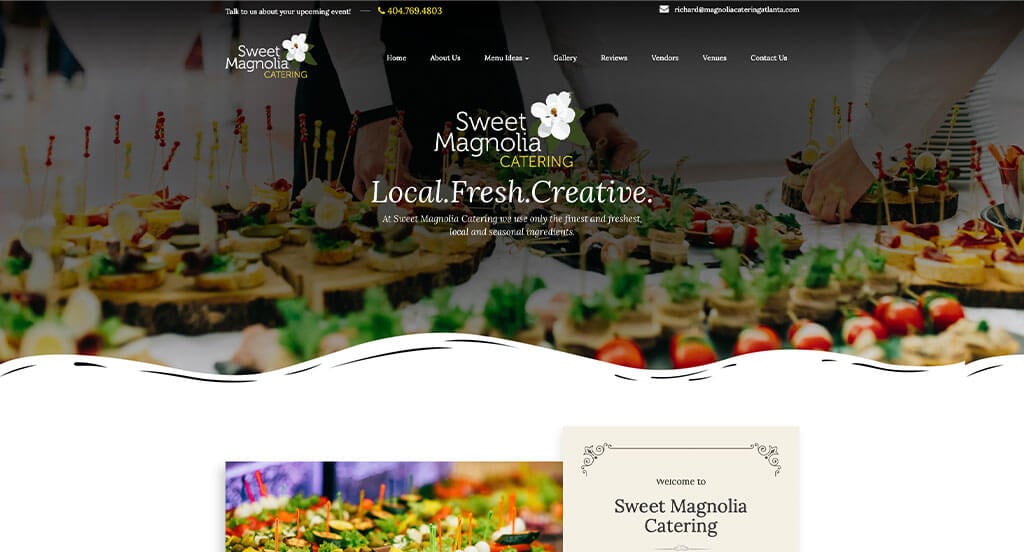
This is a good example of a website design for caterers who are looking for a professional look and feel. The interesting color blocks was likely the most impactful quality in the homepage of Sweet Magnolia Catering. Another design quality in this custom catering site we noticed was the creative photo frames. They clearly had conversions in mind when building the customer review section for their website. Don’t scroll past this website when considering design ideas for your next catering website!
41. Lowcountry Catering
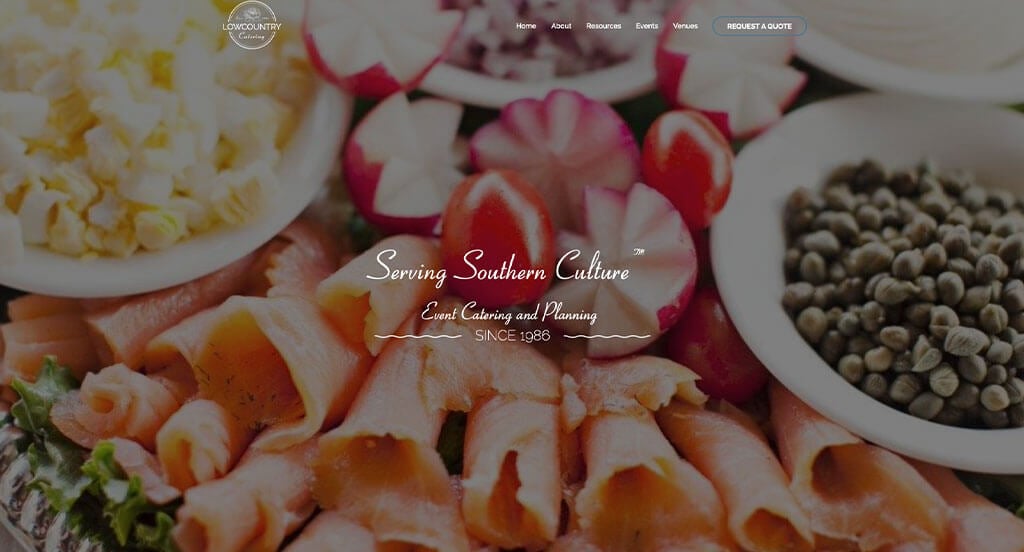
This is a good example of a website design for caterers who are looking for a professional layout. The automatically playing video was probably the most impactful quality in the homepage of Lowcountry Catering. The fancy fonts mixed with boring fonts was definitely refreshing for a professional catering site. They had digital marketing in mind when creating the stunning logo design for their website. There was no shortage of reasons to include this website in our list of websites for caterers to consider when designing their next website.
How to Build a Great Catering Website
Are you in the process of building a new website for your catering company? How exciting!
Let’s walk through some of the most important steps in building a new, or redesigning an existing, catering company website.
Feel free to skip the first few sections if you already have a domain name, hosting service, and website platform picked out!
1.) Purchasing a Domain Name
Picking out a domain name for your catering website is a crucial step in establishing your company’s online identity. It serves as the address that visitors will use to access your catering website, and it plays a significant role in branding and recognition of your business.
Here’s a step-by-step process to help you choose the perfect domain name:
- Brainstorm: Start by thinking of ideas for your domain name, considering the name of your business, the type of catering services you offer, and your location.
- Simplicity: Try to keep your domain name simple, easy to spell, and pronounce. Avoid using complex words, hyphens, or numbers.
- Consistency: If your business has an established brand name, it’s generally a good idea to include it in your domain name. For example, if your business name is Main Street Catering Services, don’t register a domain name such as AnytimeCatering.biz.
- Availability: Check the availability of your desired domain names before proceeding. Most common domain names have already been purchased. If that is the case, see if your desired domain name is being used and available for sale. However, be cautious about investing too much money into buying a domain name.
- Domain Extensions: Consider which domain name extension best suits your website’s purpose. While .com is the most common and widely recognized extension, there are many other options available, such as .net, .org, or industry-specific extensions like .catering.
- Legal Considerations: Before registering your domain name, conduct a trademark search to ensure it doesn’t infringe upon someone else’s intellectual property. For example, avoid registering a domain name that includes another catering company’s business name or the name of a popular food brand.
- Register the Domain: Once you’ve settled on an available domain name, it’s time to register it through a reputable domain registrar. We have found GoDaddy and Namecheap to be the easiest to manage domain name registrations.
2.) Choosing a Website Platform
After figuring out your domain name, the next step is selecting a website platform for your catering website.
Most catering companies are going to develop content-based websites with phone numbers, contact forms, live chats, or event schedulers to drive conversions.
WordPress is often a suitable platform for caterers. However, there are also options like Wix and other hosted website builders.
- WordPress: WordPress is a versatile and widely used content management system (CMS) that offers tremendous flexibility and customization options. It caters to all types of catering company websites, from simple websites showcasing menus to more complex sites offering online ordering or event booking functionality. With thousands of catering-inspired themes and helpful plugins available, WordPress allows you to create a highly customized website tailored to your catering company. It’s a great choice if you value control and want the ability to expand your website’s functionality over time. Although there is a hosted version of WordPress, most people who use WordPress have the open-source version installed on a web hosting account.
- Wix: The Wix platform offers many of the same page-building features. It is also a hosted solution. We’ve worked on catering websites built on Wix and found it to be a user-friendly page builder, so we confidently recommend it. With Wix, you won’t need a separate web hosting service.
It isn’t common to see catering companies building out ecommerce websites.
Web Hosting Requirements
If you choose a platform like WordPress or WooCommerce, you’ll need to find a web hosting service.
As a shameless suggestion, we often recommend our own web hosting service because of its compatibility with WordPress websites. For recommendations of reliable web hosting services from other hosting companies, consider the following options:
- WP Engine: This is one of our favorite web hosting services for catering companies. WP Engine offers a great control panel that simplifies the process of creating staging websites. Their seamless backup process ensures data protection. The only downside we’ve noticed is the limitations on PHP max_execution_time. Keep in mind that their pricing can increase quickly if you require upgraded services.
- SiteGround: We’ve always had a positive experience working with SiteGround. Their live chat and email support are excellent compared to more well-known hosting firms. We’ve never had to wait long to get in touch with someone, and the first person we interacted with usually resolved the issue. Their backup tools are user-friendly, and they offer reasonable pricing for catering companies.
3.) Selecting a Website Template
Most catering companies prefer to use pre-built website templates as they significantly reduce web development costs and turnaround time. However, if your catering business prefers a custom design, you can always hire a custom web developer or custom ecommerce developer to create a unique theme from scratch.
Let’s focus on suggestions for finding a pre-built website template for your catering website. Here are some links to the main theme marketplaces you can explore:
WordPress Catering Themes
You can find free themes at wordpress.org, or consider catering-inspired templates on ThemeForest.
Banquet – Themeforest
$79
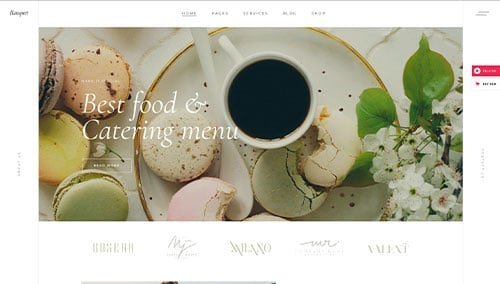
Royal Event – Themeforest
$69
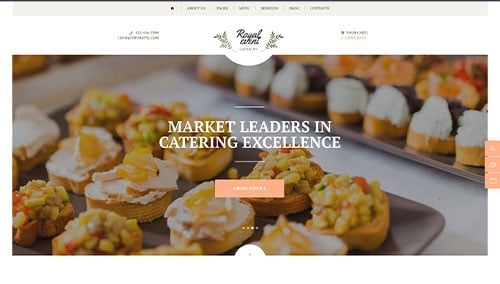
Alanzo – Themeforest
$69
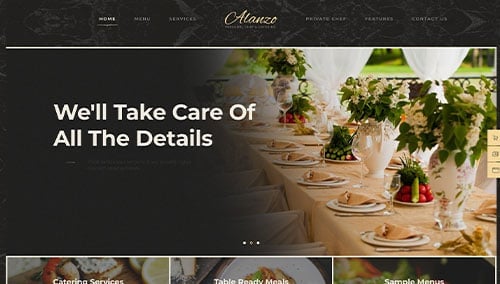
FlyFood – Themeforest
$69
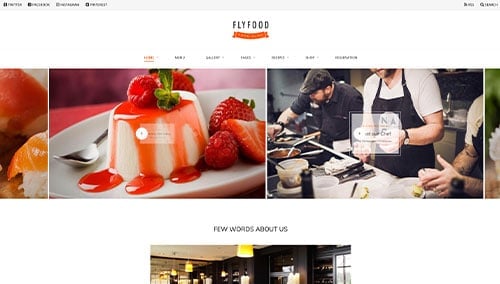
Wix Catering Themes
You can find free and paid themes in the Wix marketplace at wix.com. Some of these templates are great for catering companies.
4.) Creating Content & Adding Images
Now that you have your domain name, website platform, and theme in place, it’s time to start building content for your catering website!
Here are some helpful tips to create engaging and effective website copy specifically for catering companies:
- Know your target audience: Before writing any content, have a clear understanding of your target audience’s demographics, preferences, and needs. Tailor your content to address their pain points, provide value, and resonate with them. This will help your catering business rank in search engines for relevant catering-related searches.
- Define your key messages: Determine the main messages you want to convey through your website content. These messages should align with your brand, highlight your unique advantages, and clearly communicate the benefits of your catering services.
- Keep it concise and scannable: Online readers tend to skim content, so make sure your writing is concise and easy to digest. Use short paragraphs, bullet points, subheadings, and bold text to break up the content and improve readability.
- Create clear and compelling headlines: Craft attention-grabbing headlines that immediately convey the value and relevance of your catering business. A well-crafted headline can entice visitors to explore your website further and learn more about your services.
- Strategically incorporate keywords: Conduct keyword research to identify relevant keywords and incorporate them naturally throughout your content. This can improve your catering website’s visibility in search engine results. However, avoid keyword stuffing, as it can negatively impact readability and user experience. Tools like Ahrefs or Semrush can assist with keyword research.
- Maintain a conversational tone: Write in a conversational manner that resonates with your catering audience. Avoid jargon or overly technical language unless your target audience specifically requires it. Engage your readers by addressing them directly and using a friendly, approachable style.
- Edit and proofread: Always edit and proofread your content before publishing. Check for grammar, spelling, and punctuation errors. Ensure the flow of your content is smooth and logical, and that it aligns with your brand voice and style guidelines. Tools like Grammarly can be helpful in this process.
- Utilize ChatGPT for assistance: If you need help generating ideas or refining the content on your catering website, consider leveraging AI tools like ChatGPT.
Break up long sections of text by incorporating relevant and high-quality images into your content. Consider the following tips:
- Opt for high-quality images: Select high-resolution images that are visually appealing and well-composed. Blurry or pixelated images can detract from the overall quality of your catering website.
- Ensure relevance: Choose images that are relevant to your content and help illustrate your message. The images should enhance the text and provide additional context or visual interest for your catering services.
- Explore stock photo resources: Utilize reputable stock photo websites such as Unsplash, Pixabay, or Shutterstock. These platforms offer a wide range of professional-quality images related to catering that align with your website’s theme. Make sure to adhere to licensing requirements and attribute images as necessary.
- Customize images when possible: If you have the skills or resources, consider customizing or branding images to align with your catering brand. This can help create a cohesive visual experience for your visitors. Tools like Adobe Photoshop or Canva can assist with image customization.
- Optimize image file sizes: Compress images to optimize their file sizes without sacrificing quality. Large image files can slow down your catering website’s page speed, negatively impacting user experience and SEO. Tools like TinyPNG can help you optimize image file sizes.
5.) Post Launch Tasks and Strategies
Once you have built and launched your catering website, there are several important tasks and strategies to consider for maximizing its effectiveness. Here are some essential suggestions to help you navigate post-launch activities:
- Search Engine Optimization (SEO): Implementing SEO strategies is crucial for improving your catering company’s visibility in local search results. Conduct keyword research, optimize your content, and ensure your website has a solid internal linking structure. Regularly update and create fresh, high-quality content to attract organic traffic. Consider hiring our SEO team or exploring services from providers like The HOTH to boost your SEO efforts.
- Paid Advertising: Drive targeted traffic to your catering business by utilizing paid advertising platforms like Google Ads or Facebook Ads. Consider hiring our PPC management services or find skilled professionals on websites like Mayple for faster results.
- Conversion Rate Optimization (CRO): Analyze your catering website’s performance and user behavior using tools like Google Analytics. Identify areas where users may drop off or encounter barriers to conversion. Conduct A/B testing with tools like VWO to make data-driven changes and improve your website’s conversion rates and user experience.
- Website Security: Protect your catering website from malware and other exploits by implementing robust security measures. Ensure you have SSL certificates, web application firewalls (such as Sucuri), and regular backups in place. Keep your CMS, plugins, and themes updated to minimize vulnerabilities. Monitor your website for potential security risks and respond promptly to any issues. Consider using a service like UptimeRobot to monitor website uptime as well.
- Website Maintenance: Regularly maintain your catering website to ensure optimal performance. If you are using WordPress, this includes updating plugins and themes, monitoring website speed and performance, and resolving any broken links or errors. Consider hiring our website maintenance services or finding freelancers on platforms like Upwork to assist you. Don’t forget to regularly back up your catering website to safeguard against data loss or technical issues.
- User Feedback and Testing: Actively seek user feedback to understand visitor experiences and identify areas for improvement. Implement user testing to gather insights on how users interact with your catering website. Utilize this feedback to make iterative enhancements and continuously optimize the user experience.
- Content Updates: Keep your catering website’s content fresh and up to date. Regularly publish new blog posts related to catering, update product or service information, and ensure that all information is accurate and relevant. Engaging and valuable content not only attracts visitors but also encourages them to return and share your content with others interested in catering.
Remember, post-launch activities such as digital marketing are crucial for the long-term success of your catering website. Stay proactive, monitor performance, and adapt your strategies to achieve your business goals and meet the needs of your audience.